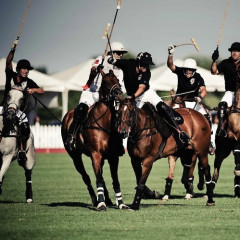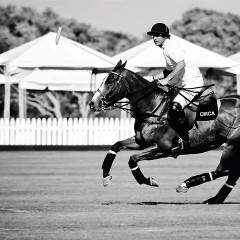 So you can put those Asprey binoculars to good use...
So you can put those Asprey binoculars to good use...
Appealing: if a player thinks an opponent has incurred a foul, he will raise his mallet above his head
Bump: when a player runs his steed into the flanks of his opponent's
Check and turn: slow the pony enough to turn safely
Chukker: a time period in a polo match, lasting 7.5 minutes. A bell (hooter) is rung at the end of each chukker and players switch horses.
Divot-stomping: a half-time activity in which spectators replace divots (clumps of turf) made by horses hooves
Flagman: man at end line who will raise his flag above his head if a goal has been scored, or lower it if it hasn't.
Forehand: forward swing of the mallet
Handicap: every player is ranked from a scale of -2 (novice) to 10 (perfect) goals, a ranking which is based on the player's assessed value to his team. A team's handicap is the average of its players'.
High goal polo: matches between teams with a 20+ handicap
Hook: catching an opponent's mallet before it raises above his horse
Intervals: rest periods between chukkas, each lasting 3 minutes
Knock-in: if a ball passes the back line but isn't a goal, the defending team knocks it back into play
Leave it: When a player rides past the ball so his teammate behind can hit it
Line of the ball: the imaginary line a ball makes when struck
Low goal polo: matches between teams with 0-4 goal handicaps
Made pony: a seasoned steed bred for polo
Medium goal polo: matches between teams with 6-14 goal handicaps
Nearside: the left hand side of the pony
Neck shot: Hitting the ball under the pony's neck
Monster rule: the ability for any circuit governor, circuit handicap committee member, or national handicap committee member to request a review of a team's handicap (usually occurs when a player is playing far better than his rating would indicate).
Offside: the right hand ride of a pony.
Pass: to hit the ball forward or laterally to a teammate
Penalty: When a player is fouled, he is awarded a free hit whose distance depends on the foul's severity
Positions: There are four players per team, each with his own position.
Mostly offensive, first to attack, but responsible for minding his no. 3 opponent
Assists attacks of no. 1; also interchanges with no. 3
Defends opponents' attacks; passes up to offensive teammates
Basically a goalie
Ride-off: When two opposing players attempt push each other offsides to prevent the ball from being struck.
Safety: knocking the ball over one's own backline
Sideboards: short boards lining the field that keep the ball in bounds
Stick: mallet
stick and ball: practice
Tack: hitting the ball behind one's horse's rump
Throw-in (or bowl-in): after every chukker or goal, the teams face each other at midfield and the umpire throws the polo ball in between them
Turn: to deflect the ball from the direction in which it is headed
Umpires: 2 on horseback, 1 (the thirdman), on foot; these men call fouls, award penalties and fines, and recommend suspension. The thirdman is used only if the first two can't decide.


.jpg)
.jpg)



.jpg)
.jpg)
.jpg)

.jpg)


